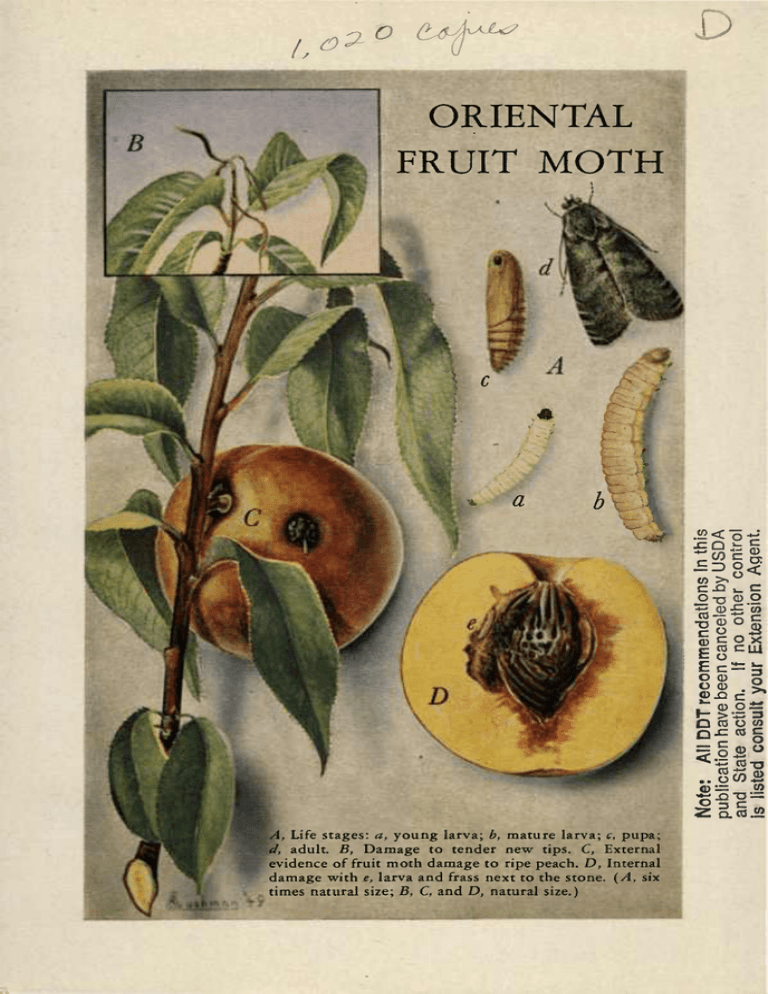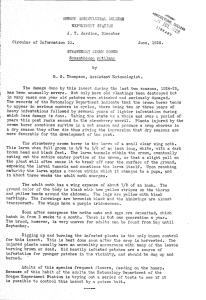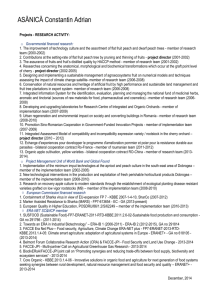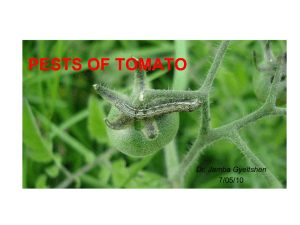^o (Uf^ ORIENTAL FRUIT MOTH HHHI
advertisement

L0^o
(Uf^
sL-^
■■■■■■■■HHHI
ORIENTAL
FRUIT MOTH
\ c
a
b
g-Q d
#i, Life stages: a, young larva; b, mature larva; c, pupa;
</, adult. B, Damage to tender new tips. C, External
evidence of fruit moth damage to ripe peach. D, Internal
damage with e, larva and frass next to the stone. {A, six
times natural size; B, C, and D, natural size.)
Oriental Fruit Moth
The oriental fruit moth, an important pest of peaches, has apparently established itself in the northern half of
the Willamette Valley. In 1956 State
Department of Agriculture entomologists trapped a few moths near Portland and in the Salem area. In 1957 they
trapped 183 moths and in 1958 nearly
350 moths.
The pest is present throughout much
of the United States, but has been most
destructive in the East and Midwest.
On the Pacific Coast it has been of importance in restricted areas of Washington and California. This leaflet will acquaint growers with the appearance
and habits of the insect and the similarity between the damage it causes and
that of other orchard pests already established in Oregon.
The moth favors peaches and quinces
but may attack other deciduous fruits
such as apples, cherries, apricots, pears,
and plums. In the larval stage the
insect injures both twigs and fruit.
Early in the season the larvae bore
into the tips of tender twigs and cause
them to wilt and dry up. Later as the
twigs harden and the fruit nears maturity most of the larvae bore into the
fruit. Moths appear in early spring
about the time peach trees are in bloom.
The females usually lay their eggs on
the leaves.
The newly hatched larvae feed on
twigs or fruit until mature. They then
spin cocoons in a protected place on
the tree or ground. Usually there are 4
or 5 generations each year. The insect
passes the winter as a full grown larva
inside a cocoon nearly one-half inch
long. Cocoons may be found attached
to fruit, under loose bark, in bark crevices, mummified fruit, or hollow weed
stems near the tree.
The early season injury to twigs
(flagging) is very similar to that caused
by the peach twig borer, whicK is/
common throughout the state. Larvae oi
the peach twig borer also will entei
fruit, especially near harvest time. Although there is similarity in the damage caused, the larvae of the two insects can be readily distinguished. The
larva of the oriental fruit moth is pink
in color and when full grown is about
one half-inch long. The larva of the
peach twig borer is brown in color with
a black head. The black color is disposed in rings encircling each segment,
giving the larva a characteristic segmented or ringed appearance.
Structurally, larvae of the peach twig
borer can be distinguished from many
other larvae, including that of the oriental fruit moth, by the presence of two
short rows of hooks (crochets) on each
anal proleg.
Details of life history and control of
the oriental fruit moth in Oregon conditions have not been fully developed.
Apparently DDT and parathion, properly applied, will give good control.
The present suggested control recommendations are applications of DDT
and/or parathion at petal fall, a second
application 10 to 12 days later, and a
third application about mid-June. DDT
is suggested at the rate of 2 pounds of
50% wettable powder or parathion at
the rate of 1 pouncl of 25% wettable
powder per 100 gallons of water. (DDT
spray also is effective against the peach
twig borer when applied at the petal
fall stage. Parathion will aid in the
control of aphids, spider mites, and
bud moth.) Growers who do not have
access to a sprayer may use a 10% DDT
dust or a 1% parathion dust or a combination of these two materials at a rate
of 40 pounds actual dust per acre. Do
not apply DDT within 30 days or parathion within 14 days of harvest.
Fungicides for brown rot control may
be added to the petal fall spray, but do
not combine Puratized Agricultural
SBEffi-QE-TAG with parathion.
^
ecause parathion is highly toxic to~^^v
warm-blooded animals, it is not recom;/
mended for use in residential areas. J)
This leaflet was prepared by the Federal Cooperative Extension Service, Oregon State College, in cooperation with the OSC Department of Entomology, the State Department of Agriculture, and the U. S.
Department of Agriculture.
OREGON STATE COLLEGE
FEDERAL COOPERATIVE EXTENSION SERVICE
CORVALLIS
Cooperative Extension work in Agriculture and Home Economics, F. E. Price, director.
Oregon State College and the United States Department of Agriculture cooperating.
Printed and distributed in furtherance of Acts of Congress of May 8 and June 30, 1914.
EXTENSION CIRCULAR 652
JULY 1958





